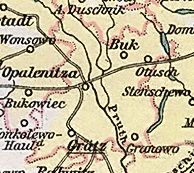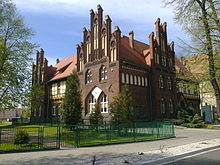District of Grätz

The district of Grätz in the west of the Prussian province of Posen existed from 1887 to 1918. The former district area today belongs to the Polish Voivodeship of Greater Poland .
size
The district of Grätz had an area of 429 km².
prehistory

The area around the western Polish city of Grodzisk Wielkopolski ( Grätz ) belonged to the Prussian province of South Prussia after the Second Partition of Poland from 1793 to 1807 . After the Peace of Tilsit , the area became part of the Duchy of Warsaw in 1807 .
After the Congress of Vienna on May 15, 1815, the area again fell to the Kingdom of Prussia . Until October 1, 1887, it belonged to the Buk County in the Poznan Administrative Region of the Poznan Province.
Administrative history
On October 1, 1887, the eastern part of the Buk district became the Graetz district, while the western part became the Neutomischel district .
The following came to the new district of Grätz:
- the cities of Grätz , Buk and Opalenitza ,
- the police district Grätz,
- the Buk Police District and
- Parts of the neighboring police district Kuschlin (rural community Lenker Hauland and the rural communities and manor districts Rudnik, Sliwno, Trzcionka and Turkowo).
District town and seat of the district office was Grätz.
On December 27, 1918, the Wielkopolska uprising of the Polish majority against German rule began in the province of Posen , and by December 29, 1918 the district town of Grätz was under Polish control.
On February 16, 1919, an armistice ended the Polish-German fighting, and on June 28, 1919, the German government officially ceded the district of Grätz to newly founded Poland with the signing of the Treaty of Versailles . The Grätz district became the Polish powiat Grodzisk . On April 1, 1932, the powiat Grodzisk was dissolved and reunited with the powiat Nowy Tomyśl .
Population development
| year | Residents | source |
|---|---|---|
| 1890 | 32,707 | |
| 1895 | 33,650 | |
| 1900 | 34,420 | |
| 1910 | 36,483 |
Of the population in 1890, 82% were Poles and 18% German. The majority of the German residents left the area after 1919.
politics
District administrators
- 1887–1899 Daum
- 1899-1910 Boltze
- 1910–1917 Rudolf von Pommer-Esche (1872–1952)
- 1918–1919 von Klitzing ( provisional )
elections
The circle Gratz was, together with the circles costs , Neutomischel and Schmiegel the Reichstag constituency Poznań 4 . The constituency was won by candidates from the Polish parliamentary group in the Reichstag elections between 1887 and 1912 :
- 1887 Ludwig von Mycielski
- 1890 Idzizlaw Czartoryski
- 1893 Idzizlaw Czartoryski
- 1898 Stephan Cegielski
- 1903 Witold von Skarzynski
- 1907 Witold von Skarzynski
- 1912 Franciczek von Morawski
Municipal structure
The district of Grätz included the three towns of Grätz , Buk and Opalenitza . The remaining (as of 1908) 52 rural communities and 26 manor districts were combined into police districts.
Communities
At the beginning of the 20th century the following communities belonged to the district:
|
|
|
|
The Doktorowo community was incorporated into the town of Grätz on April 1, 1905.
With a few exceptions, the Polish place names continued to apply after 1815, and several place names were Germanized at the beginning of the 20th century. During the German occupation in World War II , all localities were given German names.
See also
Web links
- District of Grätz administrative history and the district administrators on the website territorial.de (Rolf Jehke), as of August 16, 2013.


